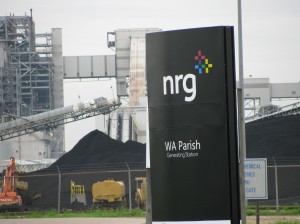Construction Begins on Largest Carbon Capture Project in the World
Here’s a head-scratcher: Over a million of tons of carbon dioxide a year will be captured from a coal plant near Houston, Texas. Then that captured carbon will be used to get more fossil fuels out of the ground, specifically from an old oilfield that’s been in use since the 1930s. Construction has begun on the Petra Nova Project, which the U.S. Department of Energy is calling “the first commercial-scale post-combustion carbon capture retrofit project in the U.S.”
The carbon capture will take place at the NRG W.A. Parish coal plant in Fort Bend County, the largest coal plant in Texas. The carbon capture project has quadrupled since its conception, now aiming to capture 90 percent of the emissions from one of the generating units at the plant. That carbon dioxide will be compressed and sent via pipeline 80 miles away to the West Ranch Oil Field
Dave Fehling of StateImpact Texas took a look at the project in February 2012:
“The W.A. Parish plant burns some 36,000 tons of coal a day, producing tons of carbon dioxide, a major greenhouse gas linked to climate change. The CO2 would normally go up and out the smokestacks. But now with the new system, the gas will be “captured” before it leaves the stack by spraying it with a chemical solvent. Then, the CO2 gas will be compressed and fed into a pipeline.
This is where what had been pollution becomes a way to produce oil.
This process of rejuvenating old oil fields by pumping in CO2 has been used for several decades, especially in West Texas. But getting the CO2 from a power plant is what’s new.”
The Department of Energy (which is providing part of the funding for the project) has more on how the process will work, and what will happen to the carbon dioxide after it’s used for enhanced oil recovery:
“The Petra Nova Project will capture 90 percent of the CO2 using a process previously deployed in a DOE-sponsored 3-year pilot-scale test in Alabama where it successfully captured more than 150,000 metric tons of CO2 per year from a coal power plant. With this capture rate, coal-fired power generation would have a greenhouse gas footprint much lower than that of a traditional natural gas-powered plant.
After compressing and transporting the captured CO2 via pipeline, the greenhouse gas will be used to displace previously unreachable oil. Once the oil is separated from the CO2, the greenhouse gas will be injected back into the underground oil field for permanent storage. Carbon dioxide has been successfully used since the early 1970s to safely bring up more oil from reservoirs previously considered to be uneconomic for further production.”
NRG is also looking at using carbon capture at some of its other coal power plants.
“Currently, from conventional operation, West Ranch is producing around 500 barrels of oil a day,” Arun Banskota, CEO of Petra Nova, tells Houston Public Media‘s Andrew Schneider. “Once we are able to get carbon dioxide into the West Ranch oil field, that field will produce something in the range of 15,000 barrels a day.”
Here’s a short radio story on the project from Houston Public Media today:

